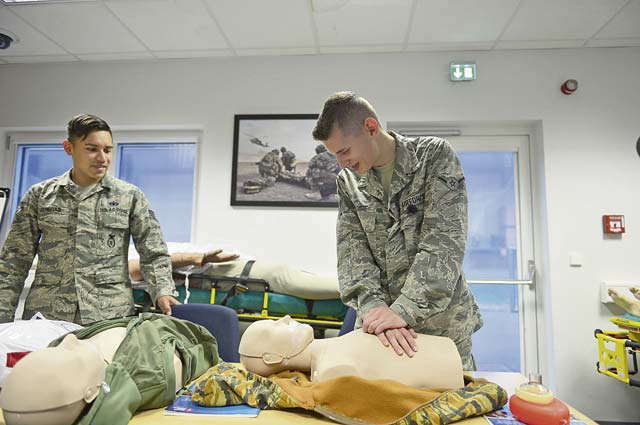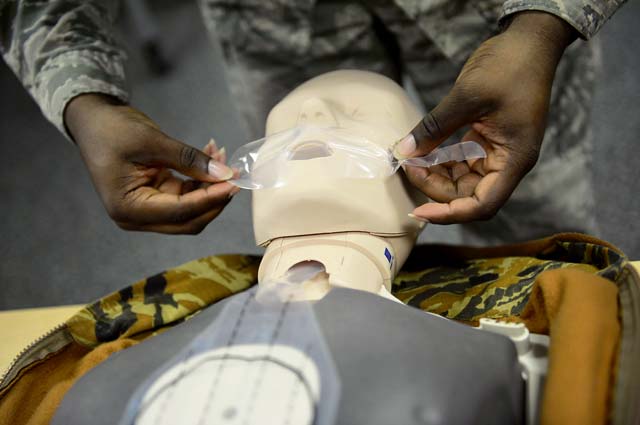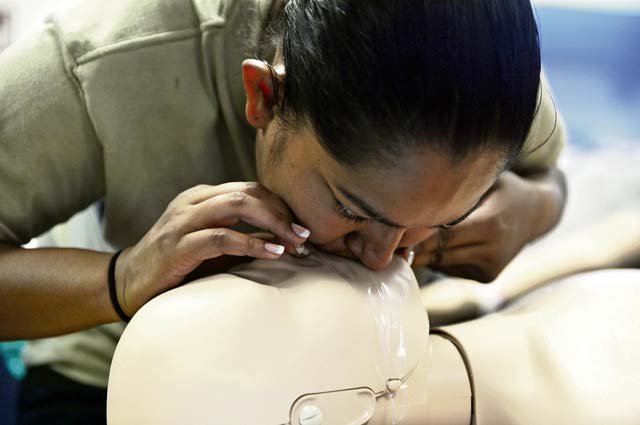
The 86th Medical Group conducted CPR training for personnel from squadrons Aug. 3 on Ramstein.
The monthly training is intended to prepare Airmen and civilians to be their unit’s CPR training representative.
Staff Sgt. Melinda Wiltse, 86th MDG emergency medical technician, said those interested in taking the course must have prior certification in adult, child and infant CPR. In order to obtain initial certification, prospective participants can reach out to their unit CPR training representative. If there is no representative in their unit, they can go to the 86th Medical Group for their certification, Wiltse added.
“Most units require a trained CPR representative,” she said. “The units have physical training leaders in their units, and CPR training is a prerequisite to taking the PTL course. We have students from different units on base who participated in our training, and now they get to teach what they learned to others.”
The training began with classes in the morning touching on the principles of CPR. In the afternoon, participants applied what they learned through hands-on training using mannequins. The mannequins contain bags that inflate when a person blows into the mannequin’s mouth and are designed to provide a realistic training experience.
Wiltse presented the training in a way similar to a train-the-trainer event, in which participants not only refresh their knowledge on the subject at hand but learn how to teach the skill to others. Wiltse showed students how to set up the classroom, what materials and mannequins to use and how to teach the course.
Wiltse teaches two kinds of CPR: heart saver and healthcare provider. She describes heart saver CPR as the kind people would use in an emergency situation before first responders arrive. Healthcare provider CPR is what medical professionals would use, which involves more knowledge and more advanced techniques, she said.
In heart saver CPR, the rescuer uses 30 chest compressions with every two breaths, Wiltse added.

Contrary to popular belief, a person does not need to be drowning in water in order to require CPR, Wiltse explained. Even in an emergency on dry land, a patient may need CPR performed for them.
“You can be anywhere, anytime, and an emergency can happen just like that,” she said, snapping her fingers. “If someone, for example, took their physical training test and passed out, they might need CPR. Anything can be a potential emergency situation, and you’ll never know when it will happen.”
Wiltse stressed the importance of knowing basic emergency medical skills, saying she wished more people would learn CPR and other maneuvers. She added that the course will benefit the community through increased emergency readiness and availability of people knowledgeable about CPR.
Through 86 MDG’s monthly training program, Wiltse hopes the CPR skills she and her fellow instructors teach will spread throughout the squadrons.
“Hopefully the participants will go back to their unit and show an interest in teaching their members CPR,” she said. “The more people we have trained in CPR the better. This is such a useful skill to have, and you never know when you might need to use it. Few things are worse than needing medical assistance and not having anyone near you trained in giving it.”
Those interested in this course or in gaining initial certification can call 479-2476 or 06371-46-2476.



